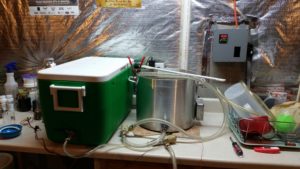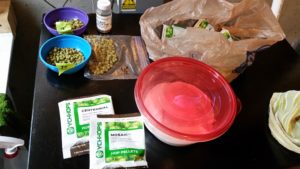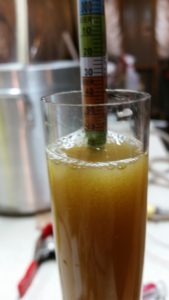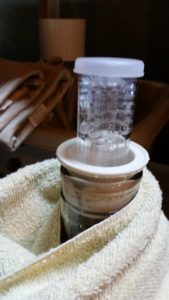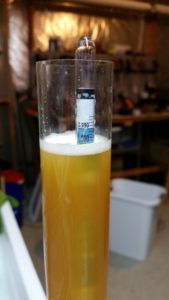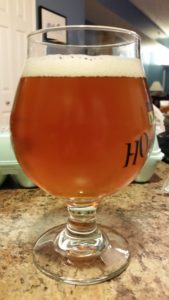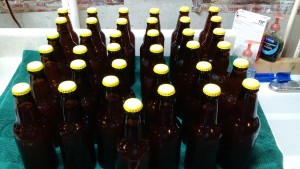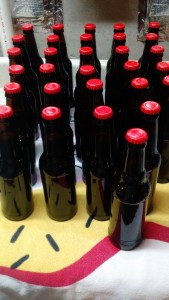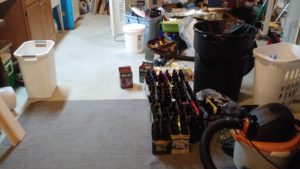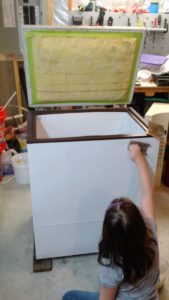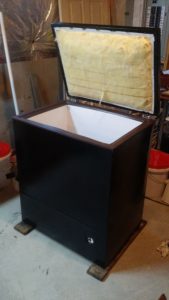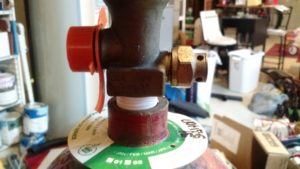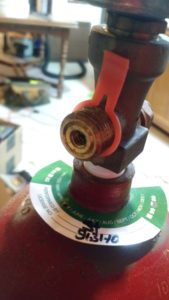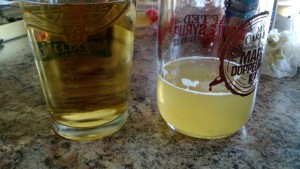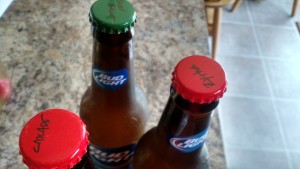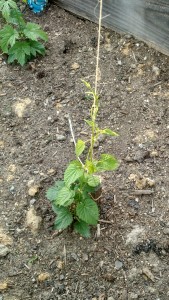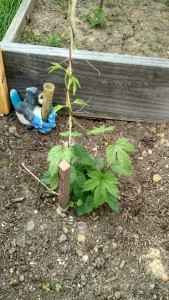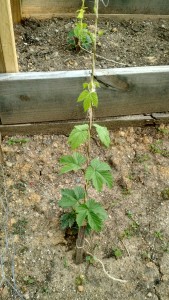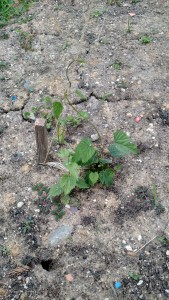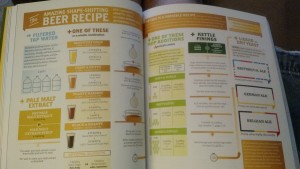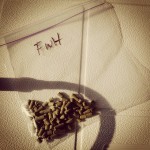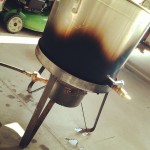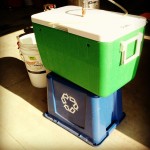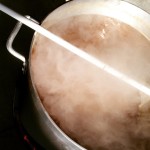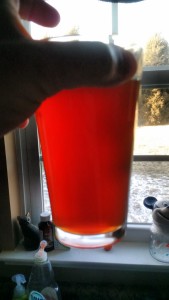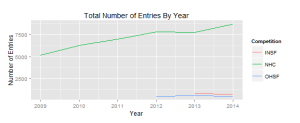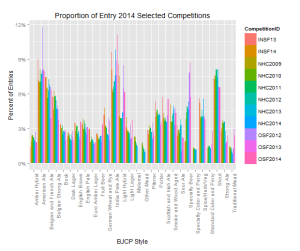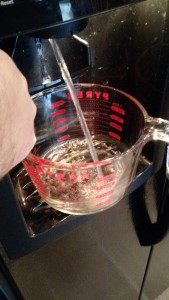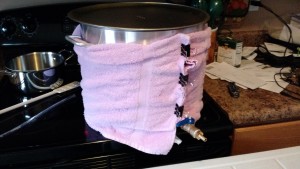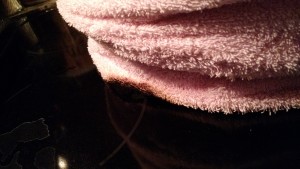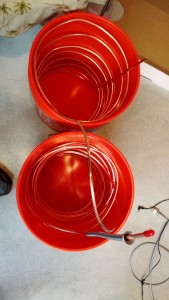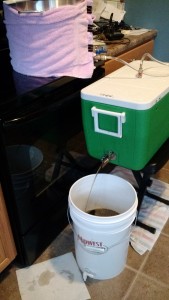Tag Archive: beer
My Minimal Oxygen Transfer Method
I made a NEIPA, which I love and hasn’t turned brown… for those unaware, these things oxidize quickly.
I fermented this in a plastic carboy to give me the potential to transfer to a keg with minimum oxygen. This was the first try, so I did have some issues (which are addressed in the procedures, I’m not talking about my screw-ups here).
1: Cold Crash (if possible)
Cold crashing will remove much of the yeast from suspension, and that will likely improve flavor. I skipped this because my fermentation chamber is unable to go below 55 (actually, I’m not even sure if it’ll go below 60, but it can keep an ale at 68).
2: Setup
The basic bare-bones of this is a gravity transfer. That being said, the fermenter needs to be up on something and the destination keg needs to low (like on the floor). You should already have a racking cane in a siphon cap and the other end should be prepared with a CO2 line. Since I don’t have an extra CO2 tank, I fitted mine with a gas post. Make sure you use Oetiker clamps or worm clams on the gas lines!

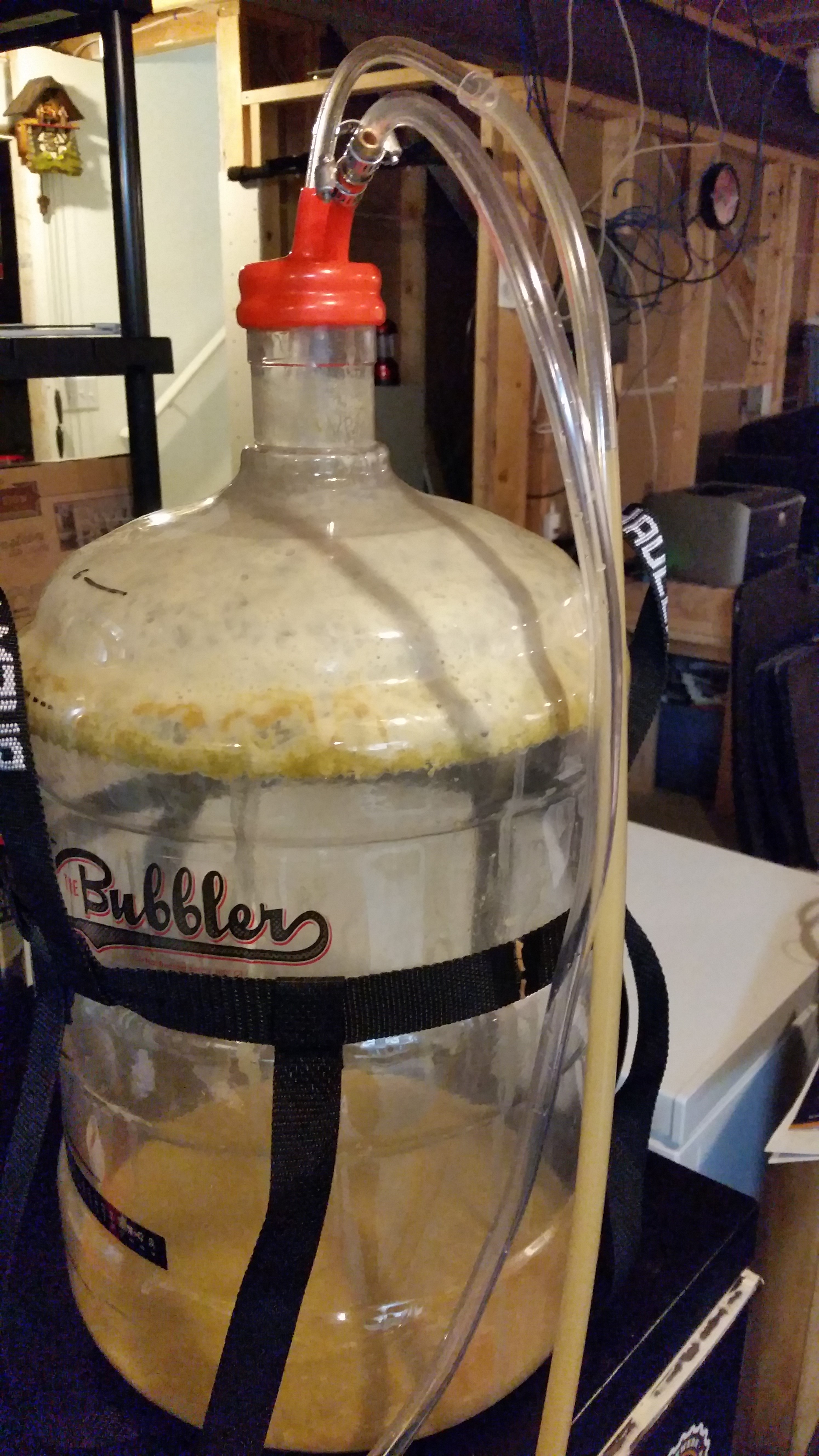
The destination keg should be purged of oxygen (fill it with CO2 and pull the pressure-release valve or otherwize depressurize the keg (mine are pin-lock, so I fill and then use another gas post to depressurize). Additionally, if you’re like me and don’t want to move your CO2 tank, you can use an empty keg as a temporary tank – purge that keg and then pressurize.
If you keg hop, as I did with this, bag the hops and place in the keg before purging.
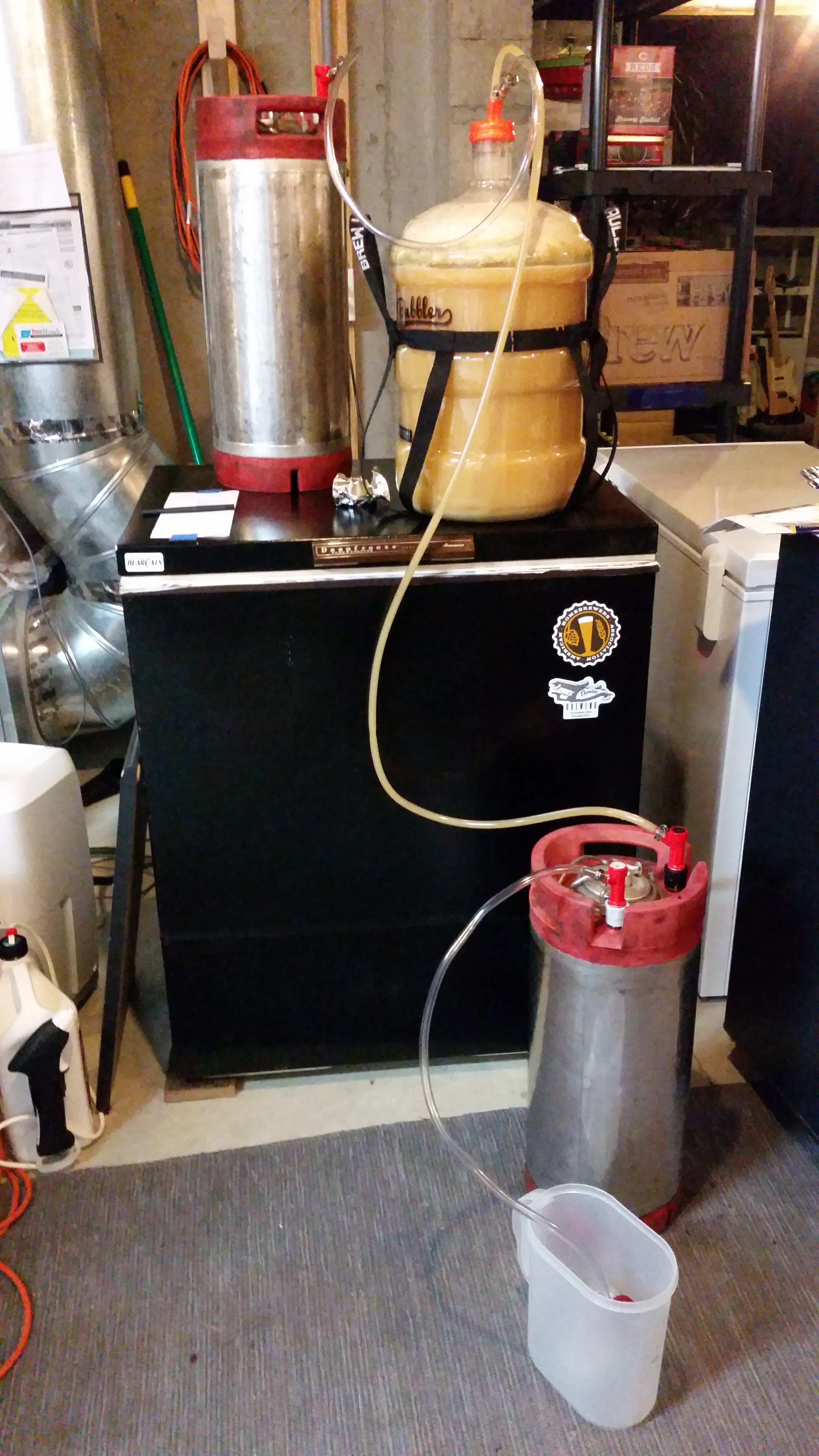
The only time the fermenter has any oxygen exposure is if you have to remove a blow-off or airlock to place the carboy cap. That should be done quick, and prior to doing that, the cap, cane, and line should be sanitized and the posts (on the ends of the lines connected to the carboy cap) should be fully assembled. If you’re using a CO2 tank, connect it and push a little CO2 through it before making the switch.
3: Begin Transfer
Connect the lines in this order:
- Fermenter to Keg
- Keg gas out (into a container of sanitizer, like a blow-off tube).
- HOLD ONTO THE FERMENTER CAP!
- Push (DO NOT CONNECT) the CO2 keg (if using a CO2 tank, use a very low pressure)
- DURING THE TRANSFER, make sure to continually supply CO2 to the fermenter – if it is closed it will start to implode and the siphon will slow.
At some point, the flow will stop. It is unlikely that there will be enough pressure to force beer out through the gas line, what tends to happen is that once the beer gets to it, it’ll stop. If there happens to be enough pressure, you’ll see beer getting into the sanitizer – that’s your signal to stop! Disconnect the keg liquid line (be prepared to wipe up some spillage) and the gas line.
Once that’s done, proceed to carbonate as normal. For this beer, I force-carbonated on about 12 PSI for about a week.
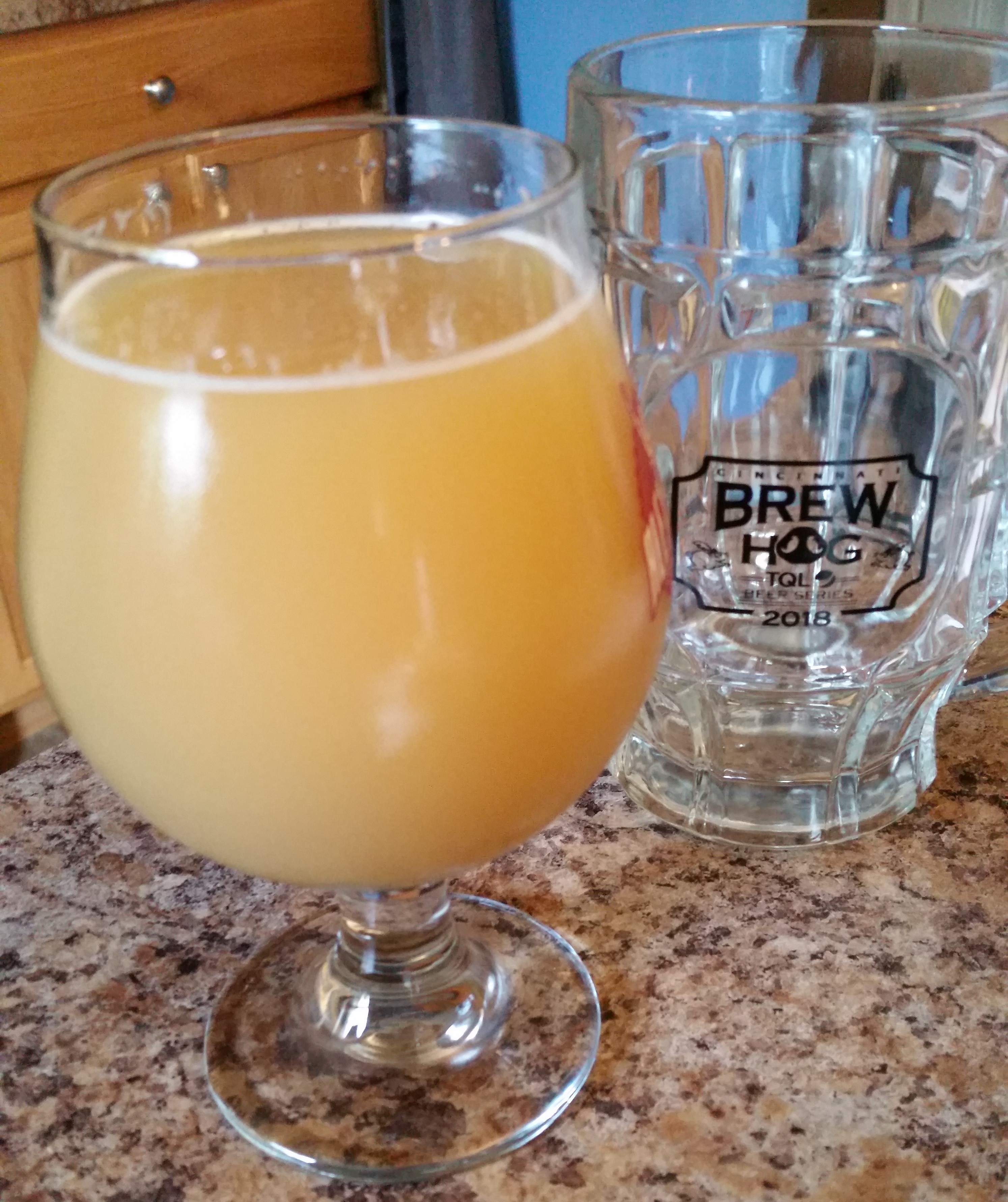
Imperial Hoptrooper Brew Day and Tasting Notes
On November 20, I brewed my biggest (and most successful in terms of numbers) beer – a double IPA. Recipe inspiration came from MadTree’s High series, which is a series of IIPAs that are quite popular and very well rated (note: there are three “highs” that I know of, the Galaxy and Citra, which are linked in the text, and Azacca which is not… but it’s also f**king tasty! There may have also been a Mosaic High).
The recipes are similar. I did a fair bit of ‘back of the napkin’ analysis on the two beers, looking at the percentages of grain, the AAU at each addition, etc. I ended up with the recipe below.
Recipe Details
| Batch Size | Boil Time | IBU | SRM | Est. OG | Est. FG | ABV |
|---|---|---|---|---|---|---|
| 5.5 gal | 60 min | 123.7 IBUs | 5.9 SRM | 1.074 | 1.014 | 7.8 % |
Style Details
| Name | Cat. | OG Range | FG Range | IBU | SRM | Carb | ABV |
|---|---|---|---|---|---|---|---|
| Double IPA | 22 A | 1.065 - 1.085 | 1.008 - 1.018 | 60 - 120 | 6 - 14 | 2.4 - 2.9 | 7.5 - 10 % |
Fermentables
| Name | Amount | % |
|---|---|---|
| Pilsner (Hoepfner) | 10.5 lbs | 72.41 |
| Vienna Malt (Briess) | 2.25 lbs | 15.52 |
| Caramel/Crystal Malt - 40L | 8 oz | 3.45 |
| Carapils (Briess) | 4 oz | 1.72 |
| Corn Sugar (Dextrose) | 1 lbs | 6.9 |
Hops
| Name | Amount | Time | Use | Form | Alpha % |
|---|---|---|---|---|---|
| El Dorado | 1 oz | 60 min | Boil | Pellet | 15 |
| Galena | 1 oz | 60 min | Boil | Pellet | 12.5 |
| Centennial | 0.5 oz | 30 min | Boil | Pellet | 10 |
| Mosaic (HBC 369) | 0.5 oz | 30 min | Boil | Pellet | 12.3 |
| Centennial | 0.5 oz | 15 min | Boil | Pellet | 10 |
| Mosaic (HBC 369) | 0.5 oz | 15 min | Boil | Pellet | 12.3 |
| Centennial | 1 oz | 15 min | Aroma | Pellet | 10 |
| Mosaic (HBC 369) | 1 oz | 15 min | Aroma | Pellet | 12.3 |
| Centennial | 2 oz | 0 min | Dry Hop | Pellet | 10 |
| Mosaic (HBC 369) | 2 oz | 0 min | Dry Hop | Pellet | 12.3 |
| Chinook | 1.5 oz | 0 min | Dry Hop | Pellet | 13 |
| Citra | 1 oz | 0 min | Dry Hop | Pellet | 12 |
Mash
| Step | Temperature | Time |
|---|---|---|
| Mash In | 152°F | 60 min |
Download
| Download this recipe's BeerXML file |
I kept closer to the size of the Citra High recipe, mostly because I am still working through efficiency issues (it’s getting better, though). I still didn’t get MadTree’s efficiency, but to be fair, I’m targeting 75%, not 82%!
Brew Day
I’m happy to say that the only issues during brew day was how long it took and higher than expected grain absorption. I started later in the day (around 2:30 PM) and it didn’t end until maybe 6:30PM. There were no stuck sparges, clogged lines or chillers, boil boiled. I ended up with about 4.5 gallons into the fermenter, which is less than the 5.5 gallons I was targeting. However, the lower volume works better with my 7.5 – 8 gallon kettle.
Throughout fermentation, the temperature (as measured on the side of the fermenter) stayed at 68, which is a nice perfect temperature.
Tasting Notes
Aroma: Grapefruit mostly
Appearance: Copper, opaque. White head that starts thick and persists as a thin head.
Taste: Tongue lashing bitterness with citrus tones. Some alcohol flavor.
Mouthfeel: Moderately carbonated, slight citrusy tartness lingers past the dry finish.
Overall Impression: I’m biased, but I love this beer. I’ve been drinking the heck out of this!
OG: 1.071
SG: 1.005
ABV: 8.7%
IBU: 124
SRM: 6
What’s Next With This Recipe?
I want to try two things – one is maybe a little less bitterness. The other is honey instead of sugar. I’m wondering if some Orange Blossom honey would work well with the citrus based hops.
Cheers!
Hammerdown Brew Cup Soapbox
I entered four beers into the Hammerdown Brew Cup. This is by far the most that I’ve ever entered into a competition. These beers I feel really good about.
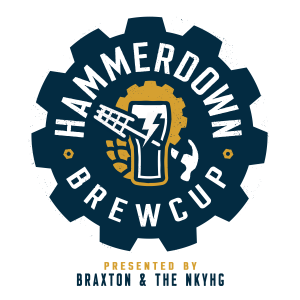
Mesa Cerveza Vienna Lager
This is from a recipe I copied and adjusted from Five Blades Brewing. The adjustments were because of my less efficient system and because my LHBS didn’t have Blackprinz (and I’ve never seen it there). I used Carafa III instead, which is a dark de-bittered malt. The taste is slightly nutty, not at the level of a nut brown, though. I find it quite pleasing and it pairs well with Mexican (or well, Mexican-styled American) food. There will be more of a blog post about this one coming soon. Entered as 07A: Vienna Lager.
Don’t Pout Cherry Stout
This is a milk stout where I racked a gallon onto some canned cherries. While the base beer is just okay, the cherries make it taste quite pleasing. The base beer uses Carafa II, which doesn’t really have the roasty flavor of roast barley that I was looking for (the LHBS was out of roast barley when I was getting ingredients). Entered as 29A: Fruit beer.
Brew United Kölsch
This beer has been talked about extensively before and it scored pretty well at Brew United. However, I’m not a huge fan of the beer and gave away copious amounts of this beer – everyone else loved it. So I’m seeking validation. Entered as 05B: Kölsch.
Vampire Dust
Sometimes I just want to experiment. So I did. This is a pre-prohibition lager, but with Citra instead of historical hops. The BJCP 2015 guidelines specifically say that for pre-prohibition lagers, “a fruity or citrusy modern hop character is inappropriate” (57). So entering it in category 27 (historical beers) would not have been the right thing to do and would have guaranteed a poor score. Entered as a 34C: Experimental Beer. Not guaranteed to place well, of course, as it isn’t really an experiment… well, yeah, it actually was.
Judging is on April 23. Cheers!
Blogging Lull (but not a homebrewing lull)
I logged in to this blog today with the intent to post something. I have five drafts started, but none of them are finished. And I somehow doubt that I’ll finish any of them soon.
Lots of stuff going on:
- I bottled my first lager a few weeks ago
I LOVE the flavor – it’s everything I wish American Lagers were. It has a slightly sharp citrus flavor that makes me feel like it’s summer when I’m drinking it. Unfortunately, it’s undercarbonated. I can’t seem to find any style for it in BJCP, so it might be in 34B or 34C in the next competition, because even if undercarbonated I think it’s worth getting some comments from the judges (especially because it’s clean). I have two more beers for that competition. I’m absolutely going to get beers into this one since I missed the last one. - I bottled a black IPA
I haven’t tasted this one in a carbonated form, but it took FOREVER to ferment. I had issues with my mash temperature, I used lactic acid for the first time (to bring the strike and sparge water down to a pH of 5.5), fermenting initially stalled at 1.030 (from 1.062), and the temperature in my basement fell to 60º F. Some of the tastes had a very harsh bitterness, but that fermented out (thank God!). I think it’ll be good enough, but I’m not sure if I’m going to enter it into the next competition. - I chased a WHALEZBRO
Local brewery MadTree released a BBA/Red Wine Barrel Aged Rubeus Cacao. Given work meetings, a conference call, a run over lunch, it was tight but I made it… and man, I haven’t ran that fast on a training run in a long time! The beer, BTW, was excellent! - Grain Absorption
I learned to keep copious notes since I was having some difficulty hitting my mash temperatures. I decided to log everything I could think of. In looking back in the last few logs, I found that my grain was absorbing A LOT more than BeerSmith’s default 0.96 fluid ounces of strike water per ounce of grain. In fact, I’m around 1.4720 fluid ounces per ounce of grain. In searching for this on Google, this number is not out of line, but it does mean more sparge water (I find it slightly interesting, although not wrong, that it has no effect on strike water volume). - Mash Tun Modification
Since I tend to feel like I religiously have a stuck sparge, I cut my mash manifold slots deeper and added a few more. Of course because of that, I’m going to continue to monitor the grain absorption to see if I need to make on-the-fly adjustments. - Expansions
I just looked on the “Where’s My Refund” tool and found that my Federal refund is due in a few days. As soon as it hits the account, I’m buying kegs. I’m also going to buy another boil tun (going with a 10 gallon instead of an 8 gallon). Lastly, I’m going to buy a few more fermenters. The current one may become a sours fermenter. - Science!
I ordered an inexpensive eBay China special microscope. It’s a waste of money. I started a post, but I have a few things to do before it is ready. The tl;dr: “buy a real microscope, don’t skimp on cheap crap from China”. The other tl;dr: “You can’t see yeast with something you paid less than $20 for”. - MOAR BREWING!!!
I have three or four or five things I want to brew, including an IPA (of course!), a saison, an American wheat (or maybe a hefeweizen), a berlinerweisse, and a Vienna lager. I am going to run in to an issue with controlling fermentation temperatures and having a kegerator. I have ideas, but nothing that I’ve done… yet. - This Weekend in Beer Drinking
I may start posting something weekly about notable beers I’ve drunk. This could get interesting. - Running
I’ve managed to keep my injuries at bay since before Christmas and I registered for the Moerlein Beer Series for the fourth year in a row. I’ve made some changes nutrition-wise that may mean that I can keep things together (pun intended!) permanently.
Kegerator! The Plan.
If my last post didn’t indicate that I LOATHE bottling, I’m not sure what I could have said to get that point across.
While bottling has the cost part down (a 6-pack of bottles costs around $10 and comes with free craft beer), it has a number of disadvantages:
- Bottles are breakable
- Bottles take up a ton of room
- Capping 30-50 bottles at a time is no fun
- There’s no reliable, easy way to store clean bottles
The last point may be what has aggravated my wife. Despite the basement being “mine”, she is not at all happy with the several 6-packs of bottles in the middle of the floor. They’re in the middle courtesy of a crack in my foundation that leaks after extreme rains. Which has so far been twice, the second time left several 6-packs of empty bottles in a puddle. So they’ve been moved out for now. Into the middle of the floor.
The Plan – “Begin With The End In Mind”
My ultimate goal is a three tap keezer. One tap will (occasionally?) be a stout faucet. 95% of my beer is consumed by me, so I can have an IPA, a stout, and something else on tap. And nothing says that I can’t bottle the remains of a keg if it gets low, although the bottle guns I see look like a pain to use.
After looking at this guy’s nice keezer build on Reddit, my wife feels that it must be black and I must build a similarly nice looking collar. However, she feels mine should have a red pinstripe on it because it would make it look good with University of Cincinnati Bearcat decor. It’s really cool of her to say that since her degree is from Southwest Florida College, mine are from UC and University of South Florida.
After looking at my budget, my first few kegs will be with picnic faucets. I have more budget numbers, but they’re boring. I have more plans, but that’s boring too. The overall plan is something like:
- Paint Keezer Black, fix temperature sensor issue, and run it (for now) with the Raspberry Pi
- Begin using (seriously, I LOATHE BOTTLING ENTIRELY!)
- Build collar (may be done before #2, depending on many things)
- …?
- Profit
- Add nice faucets
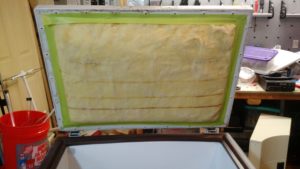
I taped the insulation to paint around it. Of course I used gloves when moving the insulation to remove the handle.
There’s a few other things I want to do. I’d love to have some way to know how much beer is left in a keg. One way I can do this is using a flow meter (such as in this article on Adafruit’s website). I don’t like the idea of a flow meter. Adafruit’s has a 1/2″ inlet and outlet, and the beer lines are smaller, so the geeky engineer in me questions the accuracy, and the homebrewer in me questions what happens to the beer in this thing. Then I thought about using weight sensors that I saw on Sparkfun’s website. As I was typing this, I found a post on HBT that even points to Sparkfun’s tutorial on their kegerator. While my implementation might deviate from this, it will be with inspiration from Sparkfun… although the first thing I thought of was this.
The Mystery Cylinder
I have a 5 lb beverage cylinder that I evidently purchased for another use in May of 2000. Yes, fifteen years ago. The gas shouldn’t go bad, but there was no label on the cylinder ever. I thought I’d call the place that I purchased the cylinder from (because it was either “air” or “CO2”, IIRC), but it appeared they went out of business many years ago (they may not have, but earlier I thought they did). I looked into things and found that as long as your tank was filled by a legitimate business (and this was), the ONLY valve on top of the tank should be a CGA 320… Okay, it could be Methyl Flouride, but I’d be shocked if I got that from a Fire Suppression Store and that it’d have a green collar on it, normally flammable stuff is red (but I could be wrong, I didn’t look into this).
I know of no other tests, but since I’m 99% sure this is CO2, I’m going to go with it.
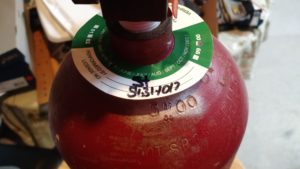
This is the date collar ring. May of 2000. This means that I will have to have the tank inspected and re-certified prior to having it filled.
Cheers!
Hops and Fermentation Controllers
I spent most of the week in Atlantic City. The running injury ruined the potential run on the boardwalk (when you’re a runner, you do these things and look forward to them). The beer is nothing particularly special (although I may have under-rated Tun Tavern’s Irish Red), but I paid for very little of what I drank. And the conference I was part of organizing went very well.
Dry Hopped Bud Light Update
I’ve made it through seven of these. Cascade, Zythos, Green Bullet, Amarillo, Columbus, Mosaic, and Galaxy. I’m sticking to 3-4 per day, and I’m using the unhopped Bud Light to reset my palate. I’ve noticed that Amarillo, Columbus, Mosaic, and Galaxy were all much more flavorful. It may be just mis-measurement in hopping, though.
I’ve been thinking of doing something like this for malt. The flavor of hops is pretty important in some styles (like IPAs), but will traditionally take a back seat to malt in other styles (like damn near every other style, to widely varying degrees).
Homegrown Hops Update
I got a text from my wife on the day I was to leave Atlantic City noting that one of our kids noticed that the hops seemed taller. They indeed grew over the week.
Fermentation Controller Update
I worked a lot on the fermentation controller. The Brewery IoT page now shows real temperatures (it’s my basement’s temperature, but it’s real). I’ll post more about this sometime, but the short version is that it is 100% Raspberry Pi based. There are three scripts that run in cron (scheduled tasks in Linux) – a script that sends the data to my offsite webserver (the one that is serving this page), a script that checks the temperature and turns the solid-state relay on and off, and a third ’emergency stop’ script that ensures that the freezer doesn’t fall to 32 or below (which would be disabled if I ever decided to brew an eisbock).
I’m itching to brew another beer. I’m considering another IPA (shocker there!), and then almost immediately brewing a Marzen style to prepare for September. Late in the year, I have been thinking about a maple bock to brew. I still haven’t made any improvements to the setup except some hose clamps.
Cheers!
Five Books Homebrewers Should Read
Thanks to Old Man Winter and Mother Nature (both of whom SUCK), I hurt my back shoveling snow and was resting a lot over the weekend and week. Since I couldn’t work on the electric kettle (and I had the incorrect solid-state relays), everything was held off for a week.
So I started reading another beer book and thought that I’d post something about them. This list is NOT EXCLUSIVE! There is a lot of great brewing literature out there – I’m just going to talk about the four I’ve liked the most so far. These are in no order, either.
1. How To Brew by John Palmer
I’ve read this probably three times, twice on his website and a third reading the Third Edition on Kindle. The thing I like about this book is that it is very step-by-step and practical, and when he goes into discussion about what is happening behind the scenes (particularly in the all-grain chapters), the author clearly indicates that he is going to explain things for a while and what chapter to go to if you just want to brew. In fact, the author does that in another place – the beginning. The book starts out with brewing your first extract brew (which I believe is a good place to start, even if you brew one extract brew like me).
2. The Complete Joy of Homebrewing by Charlie Papazian
After reading How To Brew, this is a little bit of a review, but I think this book clearly shows that brewing beer is not an uptight process. The book drives home the point of “Relax, don’t worry, have a homebrew”. It is somewhat of a review after reading How To Brew, but still a good read nonetheless. The book also talks about the historical context of beer and brewing.
3. The Brewer’s Apprentice by Greg Koch and Matt Allyn
First off, brewing books written by some of the most respected craft brewers should ALWAYS be read. Greg Koch is the CEO of Stone Brewing, brewers of such high-quality brews as Arrogant Bastard Ale, several excellent IPAs (Levitation*, Self-Righteous, Ruination 1.0 [and probably 2.0, too], and many others), as well as one of my favorite milk stouts. And while I’ve skipped out on the recent Green Tea and Golden Stout collaborations, the Xocoveza Mocha Stout collaboration was excellent. Anyway, the book is more of a thinking book than a howto book (unlike the two above). There is a lot of discussion about specific ingredients (like hops) and specific processes (like mashing). This is a book to read with a beer in your hand when your carboys are full and you want to think about brewing the next beer.
4. Tasting Beer: An Insider’s Guide to the World’s Greatest Drink by Randy Mosher
This book is not about brewing, it’s about tasting. Tasting is an important part of brewing beer, especially if you want to brew better beers (and who doesn’t?). Taste is a critical part of evaluating beer, whether it’s your own or someone else’s. It’s also an important part of recipe formulation. This book really hits its stride around chapter 4 when the discussion moves into the sensory evaluation of beer (judging), beer presentation (glassware, pouring, etc), and beer and food pairing.
5. Mastering Homebrew by Randy Mosher
This is a book that should be purchased as a printed book as opposed to an eBook version. While it is a little more expensive that way, the book is full of pictures and tables that explain a lot of the more complex brewing processes in a simpler, almost infographic-with-text-explanation style.
I think I like reading this one at this point (6 or 7 brews, 4 or 5 all-grain brews) because of the intense discussion of grains and hops (so far), and I’m probably about 40% of the way through the book.
Cheers!
Friend of Hades IPA Recipe
So I’m starting to experiment with different malts. I started looking into various SMaSH recipes and started seeing people use different base malts. So I decided to base this one on Vienna malt instead of the normal 2-row malt. I also added some carared for color, some carapils for head retention, and crystal 40 for a touch of sweetness and color. I also kicked up the hops quite a bit since my last (extract+partial mash) IPA. The last (also first) IPA I brewed had 7oz of hops (3 oz of Cascade, 2 oz of Citra and Galaxy). This time, I added an extra 3 oz of hops. I also experimented with first wort hopping and steeping (the closest I can get to hopstanding right now).
Here is the recipe.
Recipe Details
| Batch Size | Boil Time | IBU | SRM | Est. OG | Est. FG | ABV |
|---|---|---|---|---|---|---|
| 5 gal | 60 min | 67.7 IBUs | 11.5 SRM | 1.066 | 1.015 | 6.7 % |
| Actuals | 1.051 | 1.01 | 5.4 % | |||
Style Details
| Name | Cat. | OG Range | FG Range | IBU | SRM | Carb | ABV |
|---|---|---|---|---|---|---|---|
| American IPA | 14 B | 1.056 - 1.075 | 1.01 - 1.018 | 40 - 70 | 6 - 15 | 2.2 - 2.7 | 5.5 - 7.5 % |
Fermentables
| Name | Amount | % |
|---|---|---|
| Vienna Malt | 9 lbs | 69.23 |
| Carared | 2 lbs | 15.38 |
| Cara-Pils/Dextrine | 1 lbs | 7.69 |
| Caramel/Crystal Malt - 40L | 1 lbs | 7.69 |
Hops
| Name | Amount | Time | Use | Form | Alpha % |
|---|---|---|---|---|---|
| Cascade | 0.5 oz | 15 min | First Wort | Pellet | 6.6 |
| Cascade | 0.5 oz | 60 min | Boil | Pellet | 6.6 |
| Cascade | 0.5 oz | 15 min | Boil | Pellet | 6.6 |
| Citra | 0.5 oz | 15 min | Boil | Pellet | 12 |
| Galaxy | 0.5 oz | 15 min | Boil | Pellet | 11 |
| Cascade | 0.5 oz | 5 min | Boil | Pellet | 6.6 |
| Citra | 0.5 oz | 5 min | Boil | Pellet | 12 |
| Galaxy | 0.5 oz | 5 min | Boil | Pellet | 11 |
| Cascade | 1 oz | 15 min | Aroma | Pellet | 6.6 |
| Citra | 1 oz | 15 min | Aroma | Pellet | 12 |
| Galaxy | 1 oz | 15 min | Aroma | Pellet | 11 |
| Cascade | 1 oz | 7 days | Dry Hop | Pellet | 6.6 |
| Citra | 1 oz | 7 days | Dry Hop | Pellet | 11 |
| Galaxy | 1 oz | 7 days | Dry Hop | Pellet | 11 |
Miscs
| Name | Amount | Time | Use | Type |
|---|---|---|---|---|
| Irish Moss | 0.25 tsp | 15 min | Boil | Fining |
Yeast
| Name | Lab | Attenuation | Temperature |
|---|---|---|---|
| American Ale (1056) | Wyeast Labs | 75% | 60°F - 72°F |
Mash
| Step | Temperature | Time |
|---|---|---|
| Mash In | 152°F | 60 min |
Download
| Download this recipe's BeerXML file |
Some pics from brewday, all courtesy of Instagram and me being bored:
- First time using First Wort Hops
- Waiting on boil. I need to check my propane burner’s oxygen inlet.
- Mashing in.
- Boiling
The flavor is just what I wanted. A citrus hop rollercoaster. It pours a deep copper color with a thin head. The aroma is mostly orangey (is that a word?). The taste is smooth, very citrusy that lasts for a while. At 67.7 IBU, it’s at the top of the style range, which is pretty much where I wanted it (I looked up the IBU on PsycHOPathy and Truth, both are just over 70). I love it.
Looking at Beer Competitions
I looked into a few homebrewing competitions. I think I mostly wanted to look at how big the categories are.
Data
The data I found is from the National Homebrewing Competition, the Indiana State Fair, and the Ohio State Fair. Only partial datasets were used from the state fairs, because not all the data I need is on their websites. This data is far from perfect, but I think the conclusions I make below are still valid.
Growth
As shown above, there has been a lot of growth in the National Homebrew Competition. From 2009 to 2012, it grew by 50% and by 2014 it grew even more. The states did not show any growth. We’re in a golden age of homebrewing where the Internet helps new homebrewers along, a craft beer surge that shows everyone that not all beer is a Light American Lager. I think this has helped increase the NHC.
Bud’s crack on craft brewing will likely help homebrewing as well as craft beer. After all, 44% of drinkers age 21-27 have never tasted it. Not sure if they’ve had a craft beer either, though (they could be wine or whiskey drinkers).
Styles
I visually looked through to see the top five and bottom five. I didn’t do any actual analysis other than that.
Top 5: American Ale, IPA, Stout, Belgian and French, and Belgian Strong
It is probably expected that American Ales and IPAs would be big styles. I think a lot of people that ‘stick their foot in’ to craft beer start with amber or pale ales and probably soon make it to IPAs. After being in the hobby for 6 months, I’m not shocked to see strong numbers from Stout – it seems like the non-hop-head craft beer lovers gravitate towards good stouts. Also, Stout allows for some flexibility with ingredients without becoming something not-beer. I’m also not shocked to see Belgian and French, and Belgian Strong classes represented well, as many of the homebrewers I know have a profound interest in those two classes (specifically in saisons, tripels, and quadrupels).
Bottom 5: Amber Hybrid, Strong Ale, Sour Ale, Euro Amber Lager, and Dark Lager
Amber Hybrid (which includes Northern German Altbier, Dusseldorf Altbier, and California Common) is one I would have expected to be higher, although that is mostly because of the California Common style. BYO Magazine recently did a feature article on this, perhaps we’ll see some growth there. As far as altbier, I’m not sure my three local bottle shops have any altbier that would be within these styles. I don’t know about others, but I’d sure be apprehensive of brewing a style I’ve never tasted.
Strong Ale was a little shocking. I expected more people to use barleywine to show off malt selection.
I didn’t think it was shocking that sour ale was among the bottom, but maybe that’s because I find them intimidating from the brewing standpoint.
I was shocked to see both the Euro Amber Lager and Dark Lager among the bottom five. These two style groups include some of my favorites in the lager kingdom, Oktoberfest and Schwarzbier.
From my point of view on one of the hills east of Cincinnati, though, I am partially not shocked about all but one of the bottom 5 being lagers. According to the temperature on my ale pail, fermentation holds around 64-66 degrees (Fahrenheit, 18-19 Celcius) in my basement with no temperature control. Perfect for ales, not so much for lagers. I eventually will brew some lagers, but I have to have better temperature control first.
An interesting contrast in the styles is the light hybrid group. Apparently this is pretty common in the midwest, but not nationally – it’s pretty low for NHC, but pretty high for both the state fairs. This includes cream ale, blonde ale, Kolsch, and american wheat or rye. My only guess here is that we have a local soft spot for Little King’s Cream Ale.
Growth and Losses
I looked at this by looking at the slope of the trend based on the NHC data.
The biggest growth style classes are IPA, American Ale, Stout, Belgian and French Ale, and Spice, Herb, and Vegetable Beer. I don’t find any of these shocking except the spice, herb, and vegetable class.
The losing classes are all meads. I’m not sure what to think of that. On one hand, it isn’t uncommon to find a homebrewer that is at least interested in fermenting mead. On the other hand, good honey is incredibly expensive, and that may factor into things.
The not-really-growing classes are Pilsner, Specialty Cider & Perry, German Wheat & Rye, Light Lager, and Standard Cider & Perry. Regarding cider and light lager, I’m not shocked. While I don’t think the hobby is bent against ciders, perries, and light lagers, I think there is a segment of beer drinkers that look on those three groups as being inferior. I don’t agree with them (and I have a cider experiment going on in the basement now), but I think it exists.
That leaves Pilsner and German Wheat & Rye as the odd men out. I’m not sure why, as every beer geek worth his (or her) glass knows that Pilsner is different from Light Lager (and generally regarded as far better). Perhaps it has to do with the difficulty in water chemistry and fermenting. Regarding German Wheat and Rye, I don’t know. It’s not among my favorite styles, but that doesn’t really mean anything to others.
So What’s This All Mean?
Nothing. Nada. Jack Shit. I’m a data geek in real life and wanted to look into this. Awards don’t matter, your taste does. Brew what you like, because if you come in from work and look forward to opening another homebrew, you’re doin’ it right.
…but I understand if you still want to win an award (I do). It’s kinda like getting a medal at the end of a (running) race. The medal symbolizes the work that went into training for that event. Similarly, a beer award symbolizes the work put into formulating and executing a recipe.
Cheers!
Beast of a Brew Day
I decided to brew an amber ale last weekend. Brew day started a little late because of family stuff, and it went later because of brewing stuff.
First off, I have water issues. Not dirty issues, chlorine issues. Because of that, my brewing water comes from my refrigerator as de-chlorinated cold water at around 40 degrees. I also had to do a few things related to my boiling bucket, because I really don’t like the idea of lifting 5-6 gallons (40-50 pounds) of hot water and trying to control it. And siphoning? FORGET ABOUT IT. I found that my auto-siphon bends in boiling water. So I added a valve.
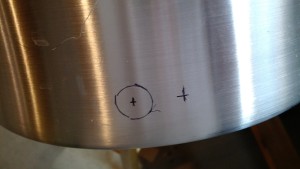
Locate twice, drill once. I nearly put it at the wrong spot, but before drilling I stopped and stood back to look and realized I wanted to go an inch to the right.
I pulled both my strike and sparge water and put them in clean ale pails before leaving for the hardware store for a valve and a cooling solution. The valve is temporary, and it even leaks, so I’m not going to show it. I’m going to order a three-part valve soon.
The Boil
The boil was long. Well, not long to boil, long to bring to a boil. I’m pushing the limit of my stove.
I used the recommendation of using a towel or blanket to keep the heat in. This made a little difference, but not enough. And it isn’t a great solution, as in the process of moving stuff around, I ended up with the following picture:
After waiting bloody-hell forever for boil to start and giving it the hour to boil, it was time to cool.
Cooling
The cooling solution sucks. I bought 1/4″ refrigerator line that I thought I’d run the wort through on it’s way to the ale pail. I figured I’d send the wort through two buckets, one with tap-cold water and the other with ice cold water.
I ran in to two problems. The first is that sanitizer in 1/4″ copper line can freeze. At least, I think that’s what happened. The other is it takes FOREVER to drain the bucket. It brought the wort down to 50F (20+ degrees below pitch temperature), although initially, some of the wort was as low as 34 degrees. It took a few hours to drain the bucket. This is not a good solution.
RDWHAHB
This was one week ago. Yesterday, prior to dry hopping, I tasted the beer from the fermenter (and tested gravity, although since dry hopping may cause additional fermentation it is an unnecessary measurement). I am VERY pleased with the flavor so far, so I think the ounce of Citra hops I threw in there will make it nearly perfect.
Regrouping
I was initially going to do another brew this weekend because January is a busy month for me. I decided that now is not the time, which means I will run out of my Left Coast IPA. That is a tragedy (I really do love IPAs), but I’ll survive, especially with that amber ale coming. I’ve decided that I need to make significant headwind at making Batavia Basement Brewing Company actually be in the basement. This means a heating element, temperature controller, water filter (this is in the works, and wife approved), and some two-phase electrical work.
Prost!
